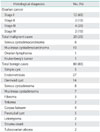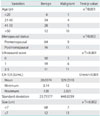1. Gillis CR, Hole DJ, Still RM, Davis J, Kaye SB. Medical audit, cancer registration, and survival in ovarian cancer. Lancet. 1991. 337:611–612.
2. Finkler NJ, Benacerraf B, Lavin PT, Wojciechowski C, Knapp RC. Comparison of serum CA-125, clinical impression, and ultrasound in the preoperative evaluation of ovarian masses. Obstet Gynecol. 1988. 72:659–664.
3. Vasilev SA, Schlaerth JB, Campeau J, Morrow CP. Serum CA-125 levels in preoperative evaluation of pelvic masses. Obstet Gynecol. 1988. 71:751–756.
4. Eisenkop SM, Spirtos NM, Montag TW, Nalick RH, Wang HJ. The impact of subspecialty training on the management of advanced ovarian cancer. Gynecol Oncol. 1992. 47:203–209.
5. Kehoe S, Powell J, Wilson S, Woodman C. The influence of the operating surgeon's specialisation on patient survival in ovarian carcinoma. Br J Cancer. 1994. 70:1014–1017.
6. Manjunath AP, Desai MR, Desai PD, Modi DA. Value of sonography in evaluation of gynecologic pelvic masses. J Obstet Gynecol India. 1999. 49:60–64.
7. Sassone AM, Timor-Tritsch IE, Artner A, Westhoff C, Warren WB. Transvaginal sonographic characterization of ovarian disease: evaluation of a new scoring system to predict ovarian malignancy. Obstet Gynecol. 1991. 78:70–76.
8. Wu CC, Lee CN, Chen TM, Lai JI, Hsieh CY, Hsieh FJ. Factors contributing to the accuracy in diagnosing ovarian malignancy by color Doppler ultrasound. Obstet Gynecol. 1994. 84:605–608.
9. Predanic M, Vlahos N, Pennisi JA, Moukhtar M, Aleem FA. Color and pulsed Doppler sonography, gray-scale imaging, and serum CA-125 in the assessment of adnexal disease. Obstet Gynecol. 1996. 88:283–288.
10. Weiner Z, Thaler I, Beck D, Rottem S, Deutsch M, Brandes JM. Differentiating malignant from benign ovarian tumors with transvaginal color flow imaging. Obstet Gynecol. 1992. 79:159–162.
11. Anandakumar C, Chew S, Wong YC, Chia D, Ratnam SS. Role of transvaginal ultrasound color flow imaging and Doppler waveform analysis in differentiating between benign and malignant ovarian tumors. Ultrasound Obstet Gynecol. 1996. 7:280–284.
12. Osmers R. Sonographic evaluation of ovarian masses and its therapeutical implications. Ultrasound Obstet Gynecol. 1996. 8:217–222.
13. Einhorn N, Bast RC Jr, Knapp RC, Tjernberg B, Zurawski VR Jr. Preoperative evaluation of serum CA-125 levels in patients with primary epithelial ovarian cancer. Obstet Gynecol. 1986. 67:414–416.
14. Chen DX, Schwartz PE, Li XG, Yang Z. Evaluation of CA-125 levels in differentiating malignant from benign tumors in patients with pelvic masses. Obstet Gynecol. 1988. 72:23–27.
15. Vasilev SA, Schlaerth JB, Campeau J, Morrow CP. Serum CA-125 levels in preoperative evaluation of pelvic masses. Obstet Gynecol. 1988. 71:751–756.
16. Jacobs IJ, Rivera H, Oram DH, Bast RC Jr. Differential diagnosis of ovarian cancer with tumour markers CA-125, CA 15-3 and TAG 72.3. Br J Obstet Gynaecol. 1993. 100:1120–1124.
17. Twickler DM, Forte TB, Santos-Ramos R, McIntire D, Harris P, Scott D. The Ovarian Tumor Index predicts risk for malignancy. Cancer. 1999. 86:2280–2290.
18. Jacobs I, Oram D, Fairbanks J, Turner J, Frost C, Grudzinskas JG. A risk of malignancy index incorporating CA-125, ultrasound and menopausal status for the accurate preoperative diagnosis of ovarian cancer. Br J Obstet Gynaecol. 1990. 97:922–929.
19. Tingulstad S, Hagen B, Skjeldestad FE, Onsrud M, Kiserud T, Halvorsen T, et al. Evaluation of a risk of malignancy index based on serum CA-125, ultrasound findings and menopausal status in the pre-operative diagnosis of pelvic masses. Br J Obstet Gynaecol. 1996. 103:826–831.
20. Tingulstad S, Hagen B, Skjeldestad FE, Halvorsen T, Nustad K, Onsrud M. The risk-of-malignancy index to evaluate potential ovarian cancers in local hospitals. Obstet Gynecol. 1999. 93:448–452.
21. Staging announcement: FIGO cancer committee. Gynecol Oncol. 1986. 25:383–385.
22. Davies AP, Jacobs I, Woolas R, Fish A, Oram D. The adnexal mass: benign or malignant? Evaluation of a risk of malignancy index. Br J Obstet Gynaecol. 1993. 100:927–931.
23. Morgante G, la Marca A, Ditto A, De Leo V. Comparison of two malignancy risk indices based on serum CA-125, ultrasound score and menopausal status in the diagnosis of ovarian masses. Br J Obstet Gynaecol. 1999. 106:524–527.
24. Yamamoto Y, Yamada R, Oguri H, Maeda N, Fukaya T. Comparison of four malignancy risk indices in the preoperative evaluation of patients with pelvic masses. Eur J Obstet Gynecol Reprod Biol. 2009. 144:163–167.
25. Manjunath AP, Pratapkumar , Sujatha K, Vani R. Comparison of three risk of malignancy indices in evaluation of pelvic masses. Gynecol Oncol. 2001. 81:225–229.
26. Clarke SE, Grimshaw R, Rittenberg P, Kieser K, Bentley J. Risk of malignancy index in the evaluation of patients with adnexal masses. J Obstet Gynaecol Can. 2009. 31:440–445.




 PDF
PDF ePub
ePub Citation
Citation Print
Print







 XML Download
XML Download